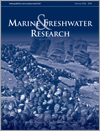Marine and Freshwater Research
Volume 69
Number 4 2018
The present study evaluated the stock structure of the grass emperor (Lethrinus laticaudis) across northern Australia using a combination of microsatellite markers, otolith microchemistry and parasite assemblages. Genetic analyses indicated at least four distinct populations. Otolith and parasite analyses, however, indicated restricted connection between populations at small spatial scales. These results show that grass emperors are vulnerable to localised depletion in areas where fishing effort is concentrated and that location-specific management arrangements may need to be considered by fisheries managers.
In the absence of biological data, marine conservation planning is often based on environmental characteristics as surrogates for biodiversity. This study demonstrated that depth categories effectively represent soft sediment mollusc assemblages in the Cape Byron Marine Park. Biotic patterns were also correlated with sediment characteristics, suggesting that inclusion of both depth and sediment type in habitat classifications systems may improve representation for infaunal molluscs.
In this study, we evaluated the effects of Pleistocene climatic fluctuations on phylogeographic and demographic histories of chub mackerel in the north-western Pacific. Sequence analysis of the mitochondrial control region revealed two distinct lineages that originated in vicariance during the Middle Pleistocene. Both lineages experienced Late Pleistocene population expansion. However, a high degree of genetic homogeneity was detected among populations. These results indicate that the interplay between historical and contemporary processes shaped present-day patterns of genetic differentiation in chub mackerel.
This study analysed ecological interactions between algae and rocky reef fish, largely unknown in the north-east Atlantic, in Spain. The seascape is dominated by kelp forests and fish assemblages are dominated by gadids, labrids and sparids. Fish and algae show different spatial preferences and respond primarily to seasonality, wave exposure and depth. Labrus bergylta, a very abundant fish, could be a good indicator species of ecosystem health.
We studied the hydrolithological characteristics that enable the development of freshwater lenses in littoral ridges underneath clayey sediments of the coastal plain. Herein, we discuss the importance of the crustacean burrows that create an interconnected system of galleries and tunnels filled with sandy-silt material that favours seepage, promoting bigger freshwater lenses in coastal environments, thus increasing water reserves.
A field-based study was used to assess the post-trawl survival of two elasmobranchs, namely the eastern shovelnose ray (Aptychotrema rostrate) and the common stingaree (Trygonoptera testacea). The results indicate that the size of an individual and time on deck are important predictors of survival. Increasing trawl duration reduced the survival of A. rostrata, whereas female T. testacea were more resilient to capture and release than male T. testacea.
There is growing conservation concern for silky sharks because of their high levels of incidental capture in tropical tuna fisheries. In the our study, we aged individuals by vertebral analysis and used a multimodel approach to estimate growth parameters. We found that silky sharks in the central west Pacific have slow growth and a late age of sexual maturity compared with other regions.
In the present study, we investigated how fish functional traits respond to the headwater–river gradient. Our findings showed that not only do the physical variables proposed in classical theory follow the headwater–river gradient in structuring fish assemblages, but s do also physicochemical variables. The present study also provided a perspective on what kind of fish species and functional traits to expect in each habitat type.
The stomach contents of bigeye tuna in the western North Pacific were observed to infer feeding habits. The highest %IRI (percentage index of relative importance) prey species was Eucleoteuthis luminosa, followed by Gonatopsis makko and Magnisudis atlantica. The %IRI of E. luminosa decreased and that of M. atlantica increased with increasing bigeye tuna body length, and the results indicate ontogenetic shifts in the feeding habits.
We re-assessed the origins of the most successful invasive marine species in southern Africa, the intertidal mussel Mytilus galloprovincialis. A combination of nuclear and mitochondrial DNA assays was applied. Results did not show southern hemisphere haplotypes, indicating the northern hemisphere as being the sole origin of invasion. Specifically, haplotype and allele frequencies pointed to north-eastern Atlantic shores as the most likely origin throughout the entire invaded range.
We conducted a field experiment to test whether visual cues influenced the relative abundance of fish on an artificial reef. Visual cues from an illusion created by a mirror installed on the reef increased the relative abundance of highly reef-associated fish. Our finding demonstrates that visual cues play a decisive role in enhancing local fish abundance on artificial reefs.
Estimates of global wetland area have increased progressively since the 1980s because of improvements in remote sensing and mapping technologies. It is not a real increase, because natural wetlands have continued to be converted and lost over the same period. The most recent estimate of global wetland area is in excess of 12.1 × 106 km2, but is still likely to be an underestimate.
Perfluoroalkyl substances were detected in several Australian freshwater species, sampled from waterways near a regional airport and former firefighting training ground. Common carp had the highest perfluorooctane sulfonate (PFOS) concentrations, and PFOS concentrations in common carp and Murray cod were above current trigger points. Different foraging habits provide some potential explanations for the differences observed among species.




